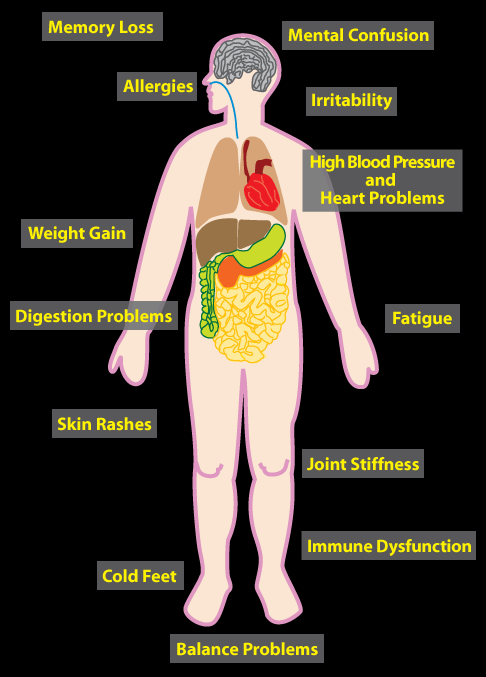Heavy metals may interact with various components of the cell such as the DNA and other proteins to cause cancer and other chronic diseases. These metals such as arsenic, cadmium, chromium, lead, and mercury causes a lot of free radical damage in the cells, affecting the metabolic and biochemical functioning of the cell. Heavy metals that get into the body through inhalation, ingestion, or dermal contact can cause diseases such as neurological, cardiovascular, diabetes, blood issues, and various types of cancers. This is why it is important to try to heavy metal detox from the body using natural chelators which have been tested scientifically and shown to work. Several herbs have been researched and have shown promise in detoxifying heavy metals such as garlic, milk thistle, cilantro, ginkgo, turmeric, Triphala, and chlorella.
Roles of Natural Herbs in Chelating Heavy Metals
Plant-based chelating compounds have recently come to light in the fight against heavy metals. Keeping the level of Metallothioneins high in the body is important to helping to eliminate heavy metals from the body. Metallothioneins are cysteine-rich proteins that bind heavy metal ions. This metallopeptidase can reduce the gastrointestinal and renal reabsorption of toxic metals and stimulate the detoxification processes. For the body to produce enough metallothioneins, it requires the amino acid cysteine and zinc.
Specific Herbs that Help Eliminate Heavy Metals
Medicinal herbs have undergone considerable research lately as a potential treatment for heavy metal toxicity.Some herbs work by “grabbing” or chelating to heavy metals and preventing their bioavailability and absorption through the gut. Other works will increase the transit time of the gut, resulting in the faster excretion of heavy metals in the faeces.
- Allium sativum
is commonly known as garlic and its main amino acid is called Allin. Allincontainssulfurr gives it the characteristic smell, and in the presence of alliinase is converted to allicin. - Sulphur-containing vegetables such as onion, leek, chives, and garlic contain organosulfur compounds that help support the liver in eliminating heavy metals such as lead and arsenic. Other vegetables that are rich in sulfur-containing amino acids are cauliflower, broccoli, cabbage, Brussels sprouts, kale, turnips, and kohlrabi.
- Garlic
has a protective effect on the liver and can help to eliminate heavy metals such as cadmium, mercury, and lead. Onion and garlic can help increase the clearance of arsenic, cadmium, iron, mercury, and lead through the liver. - Allicin can bind to heavy metals due to their positive charge, whereas most heavy metals have a negative charge. Animal experiments have shown that Garlic reduces the accumulation of cadmium or organic mercury in the liver, kidneys, bones, and testicles. Garlic can greatly increase the excretion of mercury from the brain and body. Garlic can also decrease mercury accumulation in animal brains toxic with methylmercury and remove lead from the lungs. Garlic sulfur compounds can also combine with heavy metals and be excreted through the bile and feces.
- Milk thistle
knownw also as Silybum marianumandcannbefsilprotectst the liver against oxidative stress and lipid peroxidation. - When combining vitamin C with milk thistle, can improve the detoxification of lead in the liver.
- Cilantro
(Coriandrum sativum) is a plant native to the Mediterranean region of E.. Research studies have shown that cilantro can facilitate the elimination of mercury. Even though ithasaweakerrbondthatt than allicin in garlic. Cilantro has also been effective at preventing lead from entering the bones and tissues of the body. - Ginkgo Biloba
– is a plant native to China and one of the oldest trees in existence. Ginkgo biloba is an excellent herbal remedy for lead toxicity as it inhibits the lead from causing biochemical imbalances and reduces oxidative stress and free radical damage.
One of the main active ingredients is curcumin.
Turmeric is the root of a scientifically known plant as Curcuma longa. Research has shown that curcumin can reduce liver toxicity caused by heavy metals. Such as cadmium, arsenic, lead, mercury, and chromium. It can help prevent damage to cells and tissues, as well as lipid peroxidation and increases glutathione levels so that the liver is protected against free radical damage.Most of the protective effects attributed to the curcumin arise from its ability to trap free radicals and its chelating property.Curcumin is a powerful antioxidant and anti-inflammatory. According to scientific research, curcumin can quench free radicals and prevent free radical damage.It can also boost the activity of powerful detoxification enzymes such as catalase, glutathione, and superoxide dismutase enzymes.
Phytochelatins
these are oligomers of glutathione, produced by the enzyme phytochelatin synthase. They are found in plants, fungi, nematodes and all groups of algae. Phytochelatins act as chelators, and are important for heavy metal detoxification. Phytochelatins composed of three amino acids: glutathione, cysteine, glycine (Glu, Cys, Gly). These acids have been identified in many plant species and in some microorganisms. These compounds are reported to be involved in detoxification of cadmium.



